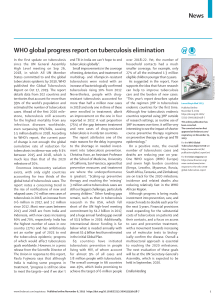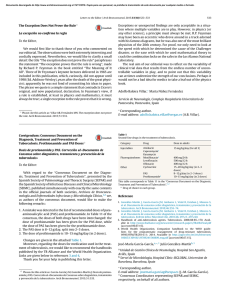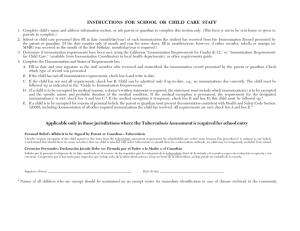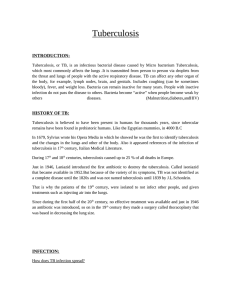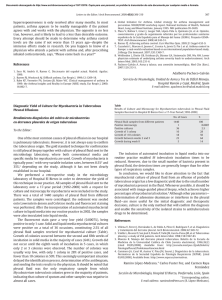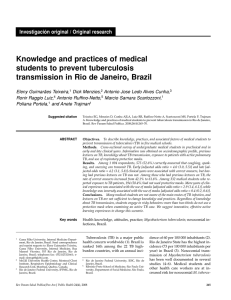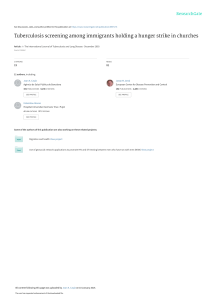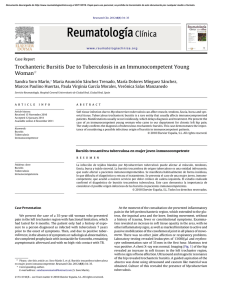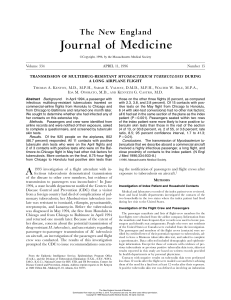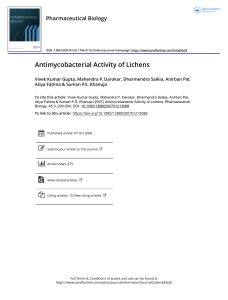Patricia Menal Mu˜noz*, Francisco Javier García Tirado, Juan José
Anuncio
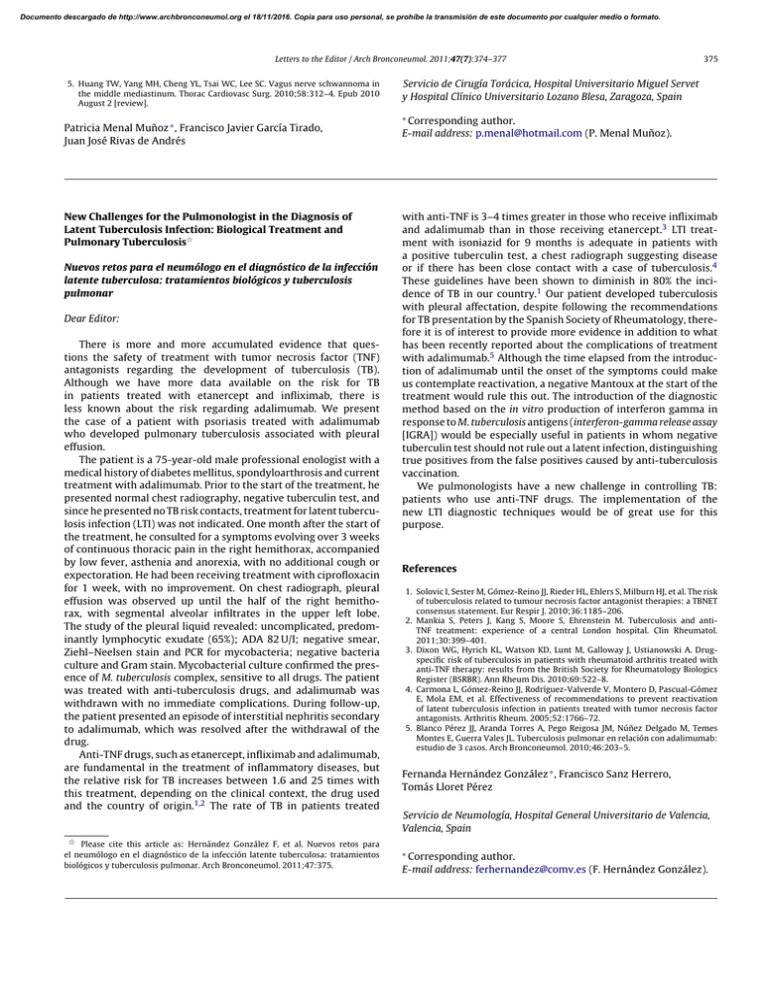
Documento descargado de http://www.archbronconeumol.org el 18/11/2016. Copia para uso personal, se prohíbe la transmisión de este documento por cualquier medio o formato. Letters to the Editor / Arch Bronconeumol. 2011;47(7):374–377 5. Huang TW, Yang MH, Cheng YL, Tsai WC, Lee SC. Vagus nerve schwannoma in the middle mediastinum. Thorac Cardiovasc Surg. 2010;58:312–4. Epub 2010 August 2 [review]. Patricia Menal Muñoz ∗ , Francisco Javier García Tirado, Juan José Rivas de Andrés New Challenges for the Pulmonologist in the Diagnosis of Latent Tuberculosis Infection: Biological Treatment and Pulmonary Tuberculosis夽 Nuevos retos para el neumólogo en el diagnóstico de la infección latente tuberculosa: tratamientos biológicos y tuberculosis pulmonar Dear Editor: There is more and more accumulated evidence that questions the safety of treatment with tumor necrosis factor (TNF) antagonists regarding the development of tuberculosis (TB). Although we have more data available on the risk for TB in patients treated with etanercept and infliximab, there is less known about the risk regarding adalimumab. We present the case of a patient with psoriasis treated with adalimumab who developed pulmonary tuberculosis associated with pleural effusion. The patient is a 75-year-old male professional enologist with a medical history of diabetes mellitus, spondyloarthrosis and current treatment with adalimumab. Prior to the start of the treatment, he presented normal chest radiography, negative tuberculin test, and since he presented no TB risk contacts, treatment for latent tuberculosis infection (LTI) was not indicated. One month after the start of the treatment, he consulted for a symptoms evolving over 3 weeks of continuous thoracic pain in the right hemithorax, accompanied by low fever, asthenia and anorexia, with no additional cough or expectoration. He had been receiving treatment with ciprofloxacin for 1 week, with no improvement. On chest radiograph, pleural effusion was observed up until the half of the right hemithorax, with segmental alveolar infiltrates in the upper left lobe. The study of the pleural liquid revealed: uncomplicated, predominantly lymphocytic exudate (65%); ADA 82 U/l; negative smear, Ziehl–Neelsen stain and PCR for mycobacteria; negative bacteria culture and Gram stain. Mycobacterial culture confirmed the presence of M. tuberculosis complex, sensitive to all drugs. The patient was treated with anti-tuberculosis drugs, and adalimumab was withdrawn with no immediate complications. During follow-up, the patient presented an episode of interstitial nephritis secondary to adalimumab, which was resolved after the withdrawal of the drug. Anti-TNF drugs, such as etanercept, infliximab and adalimumab, are fundamental in the treatment of inflammatory diseases, but the relative risk for TB increases between 1.6 and 25 times with this treatment, depending on the clinical context, the drug used and the country of origin.1,2 The rate of TB in patients treated 夽 Please cite this article as: Hernández González F, et al. Nuevos retos para el neumólogo en el diagnóstico de la infección latente tuberculosa: tratamientos biológicos y tuberculosis pulmonar. Arch Bronconeumol. 2011;47:375. 375 Servicio de Cirugía Torácica, Hospital Universitario Miguel Servet y Hospital Clínico Universitario Lozano Blesa, Zaragoza, Spain ∗ Corresponding author. E-mail address: [email protected] (P. Menal Muñoz). with anti-TNF is 3–4 times greater in those who receive infliximab and adalimumab than in those receiving etanercept.3 LTI treatment with isoniazid for 9 months is adequate in patients with a positive tuberculin test, a chest radiograph suggesting disease or if there has been close contact with a case of tuberculosis.4 These guidelines have been shown to diminish in 80% the incidence of TB in our country.1 Our patient developed tuberculosis with pleural affectation, despite following the recommendations for TB presentation by the Spanish Society of Rheumatology, therefore it is of interest to provide more evidence in addition to what has been recently reported about the complications of treatment with adalimumab.5 Although the time elapsed from the introduction of adalimumab until the onset of the symptoms could make us contemplate reactivation, a negative Mantoux at the start of the treatment would rule this out. The introduction of the diagnostic method based on the in vitro production of interferon gamma in response to M. tuberculosis antigens (interferon-gamma release assay [IGRA]) would be especially useful in patients in whom negative tuberculin test should not rule out a latent infection, distinguishing true positives from the false positives caused by anti-tuberculosis vaccination. We pulmonologists have a new challenge in controlling TB: patients who use anti-TNF drugs. The implementation of the new LTI diagnostic techniques would be of great use for this purpose. References 1. Solovic I, Sester M, Gómez-Reino JJ, Rieder HL, Ehlers S, Milburn HJ, et al. The risk of tuberculosis related to tumour necrosis factor antagonist therapies: a TBNET consensus statement. Eur Respir J. 2010;36:1185–206. 2. Mankia S, Peters J, Kang S, Moore S, Ehrenstein M. Tuberculosis and antiTNF treatment: experience of a central London hospital. Clin Rheumatol. 2011;30:399–401. 3. Dixon WG, Hyrich KL, Watson KD, Lunt M, Galloway J, Ustianowski A. Drugspecific risk of tuberculosis in patients with rheumatoid arthritis treated with anti-TNF therapy: results from the British Society for Rheumatology Biologics Register (BSRBR). Ann Rheum Dis. 2010;69:522–8. 4. Carmona L, Gómez-Reino JJ, Rodríguez-Valverde V, Montero D, Pascual-Gómez E, Mola EM, et al. Effectiveness of recommendations to prevent reactivation of latent tuberculosis infection in patients treated with tumor necrosis factor antagonists. Arthritis Rheum. 2005;52:1766–72. 5. Blanco Pérez JJ, Aranda Torres A, Pego Reigosa JM, Núñez Delgado M, Temes Montes E, Guerra Vales JL. Tuberculosis pulmonar en relación con adalimumab: estudio de 3 casos. Arch Bronconeumol. 2010;46:203–5. Fernanda Hernández González ∗ , Francisco Sanz Herrero, Tomás Lloret Pérez Servicio de Neumología, Hospital General Universitario de Valencia, Valencia, Spain ∗ Corresponding author. E-mail address: [email protected] (F. Hernández González).
